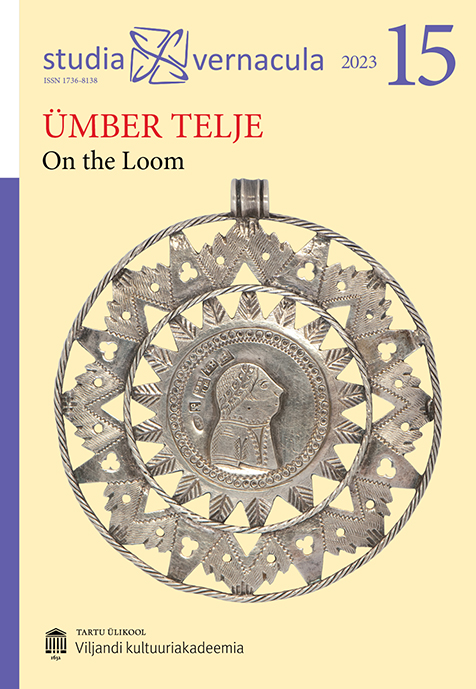Kohalik ja kordumatu kodarraha: tüpoloogia ja valmistamise tehnoloogia / Local and unique wheelcoins: typology and technology
DOI:
https://doi.org/10.12697/sv.2023.15.64-87Abstract
Wheelcoins were one of the most festive and expensive pieces of jewellery among the Estonian peasantry. These items were made of silver by learned goldsmiths operating in towns. Wheelcoins were the most recent, albeit last, development in the long history of local peasant jewellery. Several other types of jewellery which preceded the appearance of the wheelcoins, such as coins with a loop and paater pendants, influenced the form and wearing tradition of the wheelcoins.
From the end of the 18th century until the last quarter of the 19th century, wheelcoins gradually lost their fashionable position in traditional costume. The tradition of wearing and making wheelcoins ceased as it was, replaced by urban fashion. In the 1920s, wheelcoins returned to the public spotlight as pieces of unique local jewellery. In research papers by Ilmari Manninen, Aino Voolmaa, Kaalu Kirme, Reet Piiri, and Jana Reidla, the concept, typology, and use of the wheelcoin pendants were addressed within the context of folk customs and folk culture.
The article examines the development of the term ‘kodarraha’ (wheelcoin) and its attributed typology in earlier research. It should be noted that the actual name ‘wheelcoin’ appears very rarely in the collection notes of the Estonian National Museum. Peasants used other names to refer to the jewellery containing coins, such as the usual heel / loop money, neck coin, or pater. Regionally, there have been different names which indicate, for example, the use of thalers as a central coin.
Wheelcoins are one of the few ethnographic types of jewellery that can be attributed to specific masters. Thus, the names of Magnus Wilhelm Brackmann, who worked in Pärnu, Johann Friedrich Baumann, master of Lihula, and Wilhelm Adam Trühl, craftsman of Viljandi, may be referenced, as all of them can be associated with master-marked wheelcoins and distinctly individual styles.
The article proposes an alternate typology of wheelcoins to that of the regionally based one introduced by Kaalu Kirme. Established by their visual characteristics and crafting technology, this approach also takes into account the historical development of wheelcoins. The author divides wheelcoins into five groups: cast spoked wheelcoins, pseudo-cast spoked wheelcoins, single spoked wheelcoins, double spoked wheelcoins, and openwork wheelcoins.
Wheelcoins with cast spokes are the earliest examples and date mainly to the last quarter of the 18th century. Pseudo-cast spoked wheelcoins are more likely to be dated to the beginning of the 19th century. Single-spoked wheelcoins were common from the beginning of the 19th century until the last quarter of the 19th century, being the most widely produced type of wheelcoins. Wheelcoins with double spokes are common mainly in western Estonia and can only be associated with the workshops of Brackmann and Baumann. Openwork spoke wheelcoins are more common in south-east, south, and western Estonia. It is the latest dated type of wheelcoin and technically the most complex one to implement.
Finally, drawing from his own experience as a conservator and silversmith, the author gives an overview of the technology of making historical wheelcoins, and identifies and describes the different parts of the wheelcoin. Based on the close observation of the items in our museum collections, the order of work in which the wheelcoins were made was reconstructed. In the author’s findings, visible traces of processing on historical objects was relied on, and, working from them, a possible workflow for manufacturing wheelcoins was created. The different parts of the wheelcoin are counted from the centre of the piece to the outside. Thus, a single reel wheelcoin consists of a central coin or an imitation coin, spokes cut from sheet material, a girdle, and a hanging loop. In the case of a double reel wheelcoin, an intermediate girdle is added to the inner spokes, followed by an outer spoke reel and an edge girdle with a hanging loop.
By studying the dispersal and abundance of wheelcoins, it is possible to indicate the growth of peasantry wealth. The appearance of the jewellery gives an opportunity to observe how the aesthetic taste of the peasantry changed in the 18th and 19th centuries. It is also possible to detect the interaction of the peasantry with the master silversmiths of Baltic German origin who lived in towns. Here we can see the entanglement of two cultural realms, which gave birth to a unique local jewellery tradition. In conclusion, although the research on wheelcoins has already been carried out for a century, there are still details and topics that require much more in-depth study.
Keywords: wheelcoin, pater pendant, ethnographic jewellery, Estonian peasants, silversmiths, silver

